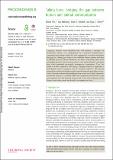Files in this item
Taking turns : bridging the gap between human and animal communication
Item metadata
| dc.contributor.author | Pika, Simone | |
| dc.contributor.author | Wilkinson, Ray | |
| dc.contributor.author | Kendrick, Kobin H | |
| dc.contributor.author | Vernes, Sonja C | |
| dc.date.accessioned | 2021-03-23T16:30:04Z | |
| dc.date.available | 2021-03-23T16:30:04Z | |
| dc.date.issued | 2018-06-13 | |
| dc.identifier | 272111196 | |
| dc.identifier | 6e2c959c-5bb5-450d-9348-e1ff84a4e10a | |
| dc.identifier | 29875303 | |
| dc.identifier | 85048334507 | |
| dc.identifier.citation | Pika , S , Wilkinson , R , Kendrick , K H & Vernes , S C 2018 , ' Taking turns : bridging the gap between human and animal communication ' , Proceedings. Biological sciences , vol. 285 , no. 1880 , 20180598 . https://doi.org/10.1098/rspb.2018.0598 | en |
| dc.identifier.issn | 0962-8452 | |
| dc.identifier.other | PubMedCentral: PMC6015850 | |
| dc.identifier.uri | https://hdl.handle.net/10023/21693 | |
| dc.description | Funding: a Sofja Kovalevskaja-Award of the Alexander von Humboldt-Foundation awarded to S.P. generously supported the project, as did a Max Planck Institute for Psycholinguistics Levelt Innovation Award awarded to K.H.K. and S.C.V., and a Max Planck Research Group awarded to S.C.V. | en |
| dc.description.abstract | Language, humans' most distinctive trait, still remains a 'mystery' for evolutionary theory. It is underpinned by a universal infrastructure-cooperative turn-taking-which has been suggested as an ancient mechanism bridging the existing gap between the articulate human species and their inarticulate primate cousins. However, we know remarkably little about turn-taking systems of non-human animals, and methodological confounds have often prevented meaningful cross-species comparisons. Thus, the extent to which cooperative turn-taking is uniquely human or represents a homologous and/or analogous trait is currently unknown. The present paper draws attention to this promising research avenue by providing an overview of the state of the art of turn-taking in four animal taxa-birds, mammals, insects and anurans. It concludes with a new comparative framework to spur more research into this research domain and to test which elements of the human turn-taking system are shared across species and taxa. | |
| dc.format.extent | 9 | |
| dc.format.extent | 327501 | |
| dc.language.iso | eng | |
| dc.relation.ispartof | Proceedings. Biological sciences | en |
| dc.subject | Animal Communication | en |
| dc.subject | Animals | en |
| dc.subject | Anura/physiology | en |
| dc.subject | Biological Evolution | en |
| dc.subject | Birds/physiology | en |
| dc.subject | Insecta/physiology | en |
| dc.subject | Language | en |
| dc.subject | Mammals/physiology | en |
| dc.subject | QH301 Biology | en |
| dc.subject | QP Physiology | en |
| dc.subject.lcc | QH301 | en |
| dc.subject.lcc | QP | en |
| dc.title | Taking turns : bridging the gap between human and animal communication | en |
| dc.type | Journal item | en |
| dc.contributor.institution | University of St Andrews. School of Psychology and Neuroscience | en |
| dc.contributor.institution | University of St Andrews. School of Biology | en |
| dc.identifier.doi | https://doi.org/10.1098/rspb.2018.0598 | |
| dc.description.status | Peer reviewed | en |
This item appears in the following Collection(s)
Items in the St Andrews Research Repository are protected by copyright, with all rights reserved, unless otherwise indicated.

